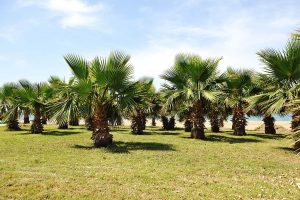If you are keen to know all there is to know about palm trees, then you might be wondering how much a palm tree weighs. There are circumstances where being able to determine the weight of a palm tree might be important, for example, if you need to have a palm tree shipped to a new location and the courier service is going to charge you by weight.
Here we will look at the ways you can find out how much a palm tree weighs and discuss the average weights for different types of palms.
On average, palms weigh between 25 lbs and 62 lbs per cubic foot, but if you know your species of palm, or are able to calculate the size of the palm, you can get a more accurate average weight.
Table of Contents
What Affects Palm Tree Weight?
Let’s take a look at the determining factors which will directly correlate with the weight of a palm tree.
Density
The density of the palm tree’s trunk (if it has one) is going to play a key factor in determining the weight. This is because the trunk of a tree will typically be the heaviest part, and the structure of the trunk can vary between different types of trees. Softwood trees have trunks that are usually less dense than hardwood trees, so if you have a softwood tree and a hardwood tree of the same size, the hardwood tree is going to weigh more because the trunk is denser.
Higher density always equals a higher weight when you are comparing two objects which are the same size. Interestingly, palm trees are not actually trees at all, and therefore they cannot be classified as either softwood or hardwood. The trunk of a palm is technically not a trunk and is, in fact, considered to be a stem.
The stem is not woody and cannot be used to produce wood like other trees. It grows in a completely different way to tree trunks, so you wouldn’t find telltale rings or grain in a palm tree trunk if you were to chop it down. Instead, the stem or ‘trunk’ of a palm tree is made from a fibrous structure that is very moist and spongy. It has a low density compared with other true trees, which means it is more lightweight.
Size

The size of a palm tree is obviously going to affect its weight. A small, young palm will of course not weigh anywhere near as much as a mature, 80-foot-tall palm. In order to work out the weight of a palm tree, calculating the size is important. You would need to find out the volume of the trunk first, which is no easy task, but it is not impossible.
This will involve finding out the height of the trunk and the radius of the trunk and then entering these figures into a calculation to determine volume. The radius of the trunk is a measurement taken from the center of the trunk to its outer edge. It will be exactly half of the trunk’s diameter, but this is not a simple measurement to take without cutting down the tree and having access to the trunk stump. However, you can find the radius if you first find out the circumference.
To find out the circumference of the trunk, use a flexible tape measure and wrap it around the trunk. Your tape measure will show you the circumference. Now you will need to divide the circumference by pi (π), which will give you the diameter, and then you can divide the diameter by 2 to give you the radius.
Once you have the radius and an estimated height of the tree, you can find out the volume of the trunk. The calculation to find out the volume of the trunk is pi (π) multiplied by the radius squared, multiplied by the height. If the radius is 3 feet, and the height is 80 feet, the calculation would look as follows: π x 3² x 80.
The answer would be 2261.95. You could then find out the total weight of the trunk by multiplying the volume (2261.95 in this example) with the density. The result won’t be exact unless your palm tree trunk has the same circumference all the way from the base to the top, but it will be a very close estimate.
Foliage
The foliage of a palm tree also needs to be taken into account when assessing the weight of a palm. One way to do this is to remove a frond from the palm, weigh it, and then estimate how many fronds there are on the tree, and multiply the weight of the single frond by your estimated amount. This will give you the rough weight of the foliage, which you can add to the weight of the trunk.
Roots and soil
If you are trying to find out the weight of a potted palm, then you’ll also need to take into account the weight of the root ball, the pot, and the soil the plant is growing in. You can do this by using an empty pot the same size as the palm pot, and filling it with a soil mixture similar to the palm, and then weighing it. This figure can then be added to your other figures for the weight of the trunk and foliage.
Palm Weight by Species
The species of the palm is going to affect the density of the trunk and, therefore, the total weight because all species grow slightly differently. Some palms will not have any trunk at all and, therefore should weigh less than palms that do, and some palms will have sturdier, heavier trunks. Palms with giant fronds will, of course, weigh more than the species with smaller, delicate fronds.
Palmetto trees are among the lightest, at an average of around 100 lbs per foot of the trunk, while Canary Island Date palms (Phoenix canariensis) can be as much as 1000 lbs per foot of the trunk. The Pindo palm (Butia capitata) sits somewhere in the middle, at around 500 lbs per foot of trunk.






